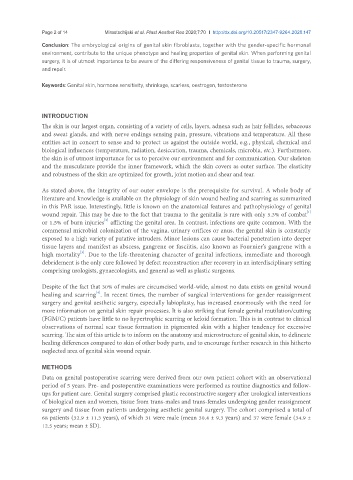Page 826 - Read Online
P. 826
Page 2 of 14 Mirastschijski et al. Plast Aesthet Res 2020;7:70 I http://dx.doi.org/10.20517/2347-9264.2020.147
Conclusion: The embryological origins of genital skin fibroblasts, together with the gender-specific hormonal
environment, contribute to the unique phenotype and healing properties of genital skin. When performing genital
surgery, it is of utmost importance to be aware of the differing responsiveness of genital tissue to trauma, surgery,
and repair.
Keywords: Genital skin, hormone sensitivity, shrinkage, scarless, oestrogen, testosterone
INTRODUCTION
The skin is our largest organ, consisting of a variety of cells, layers, adnexa such as hair follicles, sebaceous
and sweat glands, and with nerve endings sensing pain, pressure, vibrations and temperature. All these
entities act in concert to sense and to protect us against the outside world, e.g., physical, chemical and
biological influences (temperature, radiation, desiccation, trauma, chemicals, microbia, etc.). Furthermore,
the skin is of utmost importance for us to perceive our environment and for communication. Our skeleton
and the musculature provide the inner framework, which the skin covers as outer surface. The elasticity
and robustness of the skin are optimized for growth, joint motion and shear and tear.
As stated above, the integrity of our outer envelope is the prerequisite for survival. A whole body of
literature and knowledge is available on the physiology of skin wound healing and scarring as summarized
in this PAR issue. Interestingly, little is known on the anatomical features and pathophysiology of genital
[1]
wound repair. This may be due to the fact that trauma to the genitalia is rare with only 5.3% of combat
[2]
or 1.5% of burn injuries afflicting the genital area. In contrast, infections are quite common. With the
commensal microbial colonization of the vagina, urinary orifices or anus, the genital skin is constantly
exposed to a high variety of putative intruders. Minor lesions can cause bacterial penetration into deeper
tissue layers and manifest as abscess, gangrene or fasciitis, also known as Fournier’s gangrene with a
[3]
high mortality . Due to the life-threatening character of genital infections, immediate and thorough
debridement is the only cure followed by defect reconstruction after recovery in an interdisciplinary setting
comprising urologists, gynaecologists, and general as well as plastic surgeons.
Despite of the fact that 30% of males are circumcised world-wide, almost no data exists on genital wound
healing and scarring . In recent times, the number of surgical interventions for gender reassignment
[4]
surgery and genital aesthetic surgery, especially labioplasty, has increased enormously with the need for
more information on genital skin repair processes. It is also striking that female genital mutilation/cutting
(FGM/C) patients have little to no hypertrophic scarring or keloid formation. This is in contrast to clinical
observations of normal scar tissue formation in pigmented skin with a higher tendency for excessive
scarring. The aim of this article is to inform on the anatomy and microstructure of genital skin, to delineate
healing differences compared to skin of other body parts, and to encourage further research in this hitherto
neglected area of genital skin wound repair.
METHODS
Data on genital postoperative scarring were derived from our own patient cohort with an observational
period of 5 years. Pre- and postoperative examinations were performed as routine diagnostics and follow-
ups for patient care. Genital surgery comprised plastic reconstructive surgery after urological interventions
of biological men and women, tissue from trans-males and trans-females undergoing gender reassignment
surgery and tissue from patients undergoing aesthetic genital surgery. The cohort comprised a total of
68 patients (32.9 ± 11.3 years), of which 31 were male (mean 30.4 ± 9.3 years) and 37 were female (34.9 ±
12.5 years; mean ± SD).

